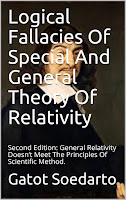TEST OF
GENERAL RELATIVITY
AT 2017
SOLAR ECLIPSE
“…during totality on August 21, 2017 — although
it will be close to midday — you’ll
easily be able to see 4 planets with the unaided eye near the eclipsed sun!
In order of brightness, these planets will be Venus, Jupiter, Mars
and Mercury. Mars is slightly brighter than Mercury, but so nearly the same in
brightness that you probably won’t notice a difference.”( Eddie Irizarry, See 4
planets during 2017 solar eclipse, earthsky.org).
At the 2017 solar eclipse, Monday, August 21, in USA, the bright
star Regulus make a thrilling sight shinning near the Sun’s corona, this event
is the best chance to test or re-examine Einstein’s general theory of
relativity.
As we know, at his theory of general
relativity, Einstein declared a new law on gravity, stating that gravity was
not a force as commonly known at the Newton’s gravity theory, but a part of
inertia. His gravity law illustrated the object behaviour at the gravity field,
for instance the planets, not in the sense of ‘the attracting forcer’ but only
in the sense of the crossing track being taken.
For Einstein, gravity is a part of inertia.
The movement of stars and planets originates from their inertia derivation, and
the crossing track taken is determined by the space metrical nature, or more
precisely the continuous space-time.
Einstein concluded that the light just as
other material objects, moved in curve if gravity field of an object was
massive. Einstein suggested that his hypothesis could be tested to observe the
crossing track of the star light at gravity field of the sun. Due to the fact
that the stars are not visible at day time, there is only one chance when the
sun and the stars can be seen together at the sky, and that is the time when
there is a solar eclipse.
Special phenomena of 2017 solar eclipse,
that we will easily be able to see 4 planets, and the bright star Regulus make
a thrilling sight shinning near the Sun’s corona.
Apparent position of the star Regulus
during total solar eclipse meet the conditions in accordance with Einstein
hypothesis
According to Einstein’s hypothesis, the
star light visible around the sun would be bent inwards, toward the sun at the
time when passing through the gravity field of the sun. Einstein calculated the
level of their deviation and predicted that for the stars observed being the
closest to the Sun, their deviation was about 1.75 seconds of an arc.
Test of general relativity
In
this test, we use terminology
"deflection of light by the Sun" as Einstein's idea on general
relativity, and Einstein proposed test via eclipse. In this book,
"tests" is made by using astronomical data that has been predicted at
the 2017 total solar eclipse, in USA, August 21.
As explained in
previous discussion, there are three steps to test general relativity using
astronomical method: determine the place of observation, measuring the apparent
altitude of star using the sextant, and
apply data to find the deviation of
starlight in the Nautical Almanac.of
2017.
To get the most accurate results, the test
should be carried out at the locations of a total eclipse, in this case in the
USA, on August 21, 2017 .
According to Earthsky Website, any location
along the path of totality from Oregon to South Carolina can enjoy good weather
on eclipse day, but the western half of the United States, especially from the
Willamette Valley of Oregon to the Nebraska Sandhills, will enjoy the very best
weather odds. Therefore, the best place of direct observation to test general
relativity is in Oregon, sea waters near the Oregon coast or on the beach of
Madras.
In this case, the measurement using a
sextant. The sextant allows us to very accurately measure the apparent
altitude of stars, it’s because there are visible horizon from the sea or beach. According to Earthsky Website, totality
begins at 10:19 a.m, and duration of totality is 2 minutes, 4 seconds.
Prediction at 2017 total solar
eclipse.
In this book, prediction is made based on astronomical data
from NASA Eclipse Website, the Astroadventure Website, and Earthsky Website.
Read more in Your Kindle Device:
Kindle eBook-Amazon.Co.UK
Einstein’s prediction or
according to general relativity, the deviation of Regulus, as the star observed
being the closest to the Sun, was about
1,75 sec. arc. But we get results as
prediction at 2017 eclipse is about 236 sec.arc. It is more than 100 times
greater than Einstein’s prediction.


















